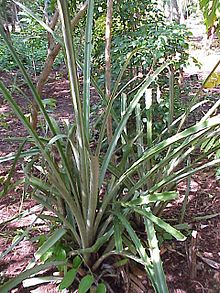
Yucca is a genus of perennial shrubs and trees in the family Asparagaceae, subfamily Agavoideae. Its 40–50 species are notable for their rosettes of evergreen, tough, sword-shaped leaves and large terminal panicles of white or whitish flowers. They are native to the Americas and the Caribbean in a wide range of habitats, from humid rainforest and wet subtropical ecosystems to the hot and dry (arid) deserts and savanna.

Sir William Jackson Hooker was an English botanist and botanical illustrator, who became the first director of Kew when in 1841 it was recommended to be placed under state ownership as a botanic garden. At Kew he founded the Herbarium and enlarged the gardens and arboretum. The standard author abbreviation Hook. is used to indicate this person as the author when citing a botanical name.
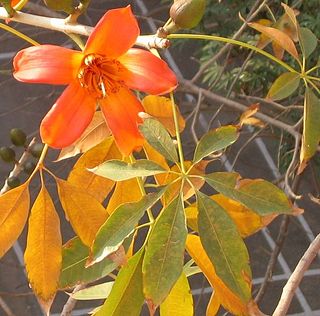
Bombax is a genus of mainly tropical trees in the mallow family. They are native to western Africa, the Indian subcontinent, Southeast Asia, and the subtropical regions of East Asia and northern Australia. It is distinguished from the genus Ceiba, which has whiter flowers.
Chaguar is the common name of several related species of South American plants of the family Bromeliaceae, among them Bromelia serra, Bromelia hieronymi, Deinacanthon urbanianum and Pseudananas sagenarius, which are non-woody forest plants with sword-shaped evergreen leaves, resembling yucca. The different varieties grow in the semi-arid parts of the Gran Chaco ecoregion.

Bromelia serra is a species of plant in the family Bromeliaceae native to South America. It is one of several plants used by the Wichí people as a fiber for weaving called chaguar.
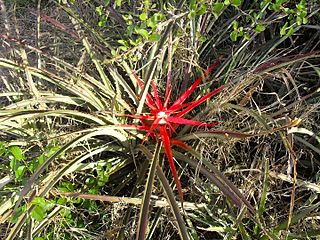
Bromelia hieronymi is a species of plant in the family Bromeliaceae native to South America. It is one of several plants used by the Wichí people as a fiber for weaving called chaguar. B. Hieronymi has anti-inflammatory agents. These agents are secreted by the fruit in the Bromelia hieronymi.

Billbergia is a genus of flowering plants in the family Bromeliaceae, subfamily Bromelioideae.
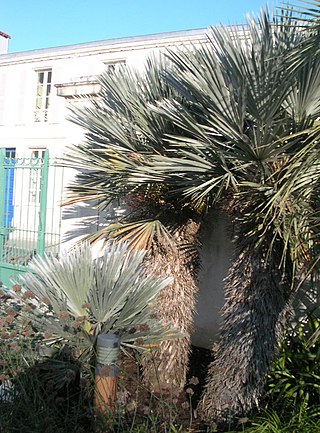
Trithrinax is a genus of flowering plants in the subfamily Coryphoideae of the family Arecaceae. The name is derived from ancient Greek, where tri means three, and thrinax trident. It was named in 1837 by Carl Friedrich Philipp von Martius, a German botanist and explorer.

Fique is a natural fibre that grows in the leaves of plants in the genus Furcraea. Common names include fique, cabuya, pita, penca, penco, maguey, cabui, chuchao and coquiza.

Agave is a genus of monocots native to the hot and arid regions of the Americas and the Caribbean, although some Agave species are also native to tropical areas of North America, such as Mexico. The genus is primarily known for its succulent and xerophytic species that typically form large rosettes of strong, fleshy leaves. Agave now includes species formerly placed in a number of other genera, such as Manfreda, ×Mangave, Polianthes and Prochnyanthes.

Bromelia antiacantha is a plant species in the genus Bromelia. This species is native to Brazil and Uruguay.
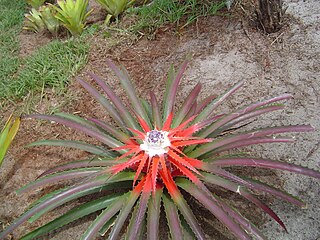
Bromelia balansae is a plant species in the genus Bromelia. This species is native to Argentina, Brazil, Colombia, Bolivia, and Paraguay where it grows at elevations of 150 to 3,000 feet.

Bromelia karatas is a plant species in the genus Bromelia. This species is native to West Indies and to Latin America from San Luis Potosí + Sinaloa south to Brazil.
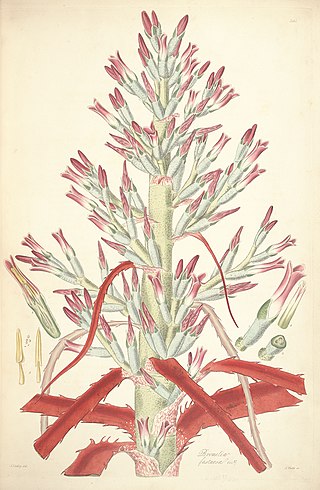
Bromelia pinguin is a plant species in the genus Bromelia. This species is native to Central America, Mexico, the West Indies and northern South America. It is also reportedly naturalized in Florida. It is very common in Jamaica, where it is planted as a fence around pasture lands, on account of its prickly leaves. The plant can be stripped of its pulp, soaked in water, and beaten with a wooden mallet, and it yields a fiber whence thread is made. In Nicaragua and El Salvador it is used to make gruel.
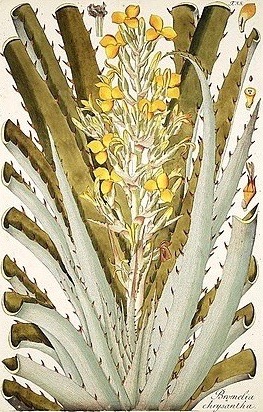
Bromelia chrysantha is a plant species in the genus Bromelia. This species is native to Venezuela, Colombia, and Trinidad & Tobago.
Bromelia goeldiana is a plant species in the genus Bromelia. This species is native to Venezuela and Brazil.

Bromelia laciniosa, natively known as macambira, is plant in the bromeliad family, or in other words, the pineapple family—though not all bromeliads resemble the common pineapple. As a family, the histories of bromeliads have been well recorded, but the details of its many species, like Bromelia laciniosa, are not known. Bromelia laciniosa is native to Brazil and Argentina but cultivated in many other places.
Vriesea schultesiana is a plant species of the genus Vriesea. This species is endemic to Colombia. It is rare, listed as "near threatened."
